HI6005 Management and Organisations: Hawthorne Studies Analysis
VerifiedAdded on 2022/09/27
|15
|1067
|23
Report
AI Summary
This report analyzes the Hawthorne Studies, a series of influential research projects conducted at the Hawthorne Works factory. The study, led by Elton Mayo, investigated the effects of various factors on worker productivity, including lighting, rest periods, and social dynamics. The report delves into the Illumination Studies, the Relay Room Experiments, and the Bank Wiring Experiments, highlighting key findings such as the Hawthorne effect, which revealed that worker behavior is influenced by observation. The study found that social and psychological factors played a crucial role in determining worker output and satisfaction. The report concludes that the Hawthorne Studies transformed management practices by emphasizing the importance of employee relationships and the social environment within the workplace, moving beyond purely economic incentives to understand the complexities of human behavior in organizations.

MANAGEMENT AND ORGANISATIONS
IN A GLOBAL ENVIRONMENT
Name of Student
Name of University
Author’s Note:
IN A GLOBAL ENVIRONMENT
Name of Student
Name of University
Author’s Note:
Paraphrase This Document
Need a fresh take? Get an instant paraphrase of this document with our AI Paraphraser
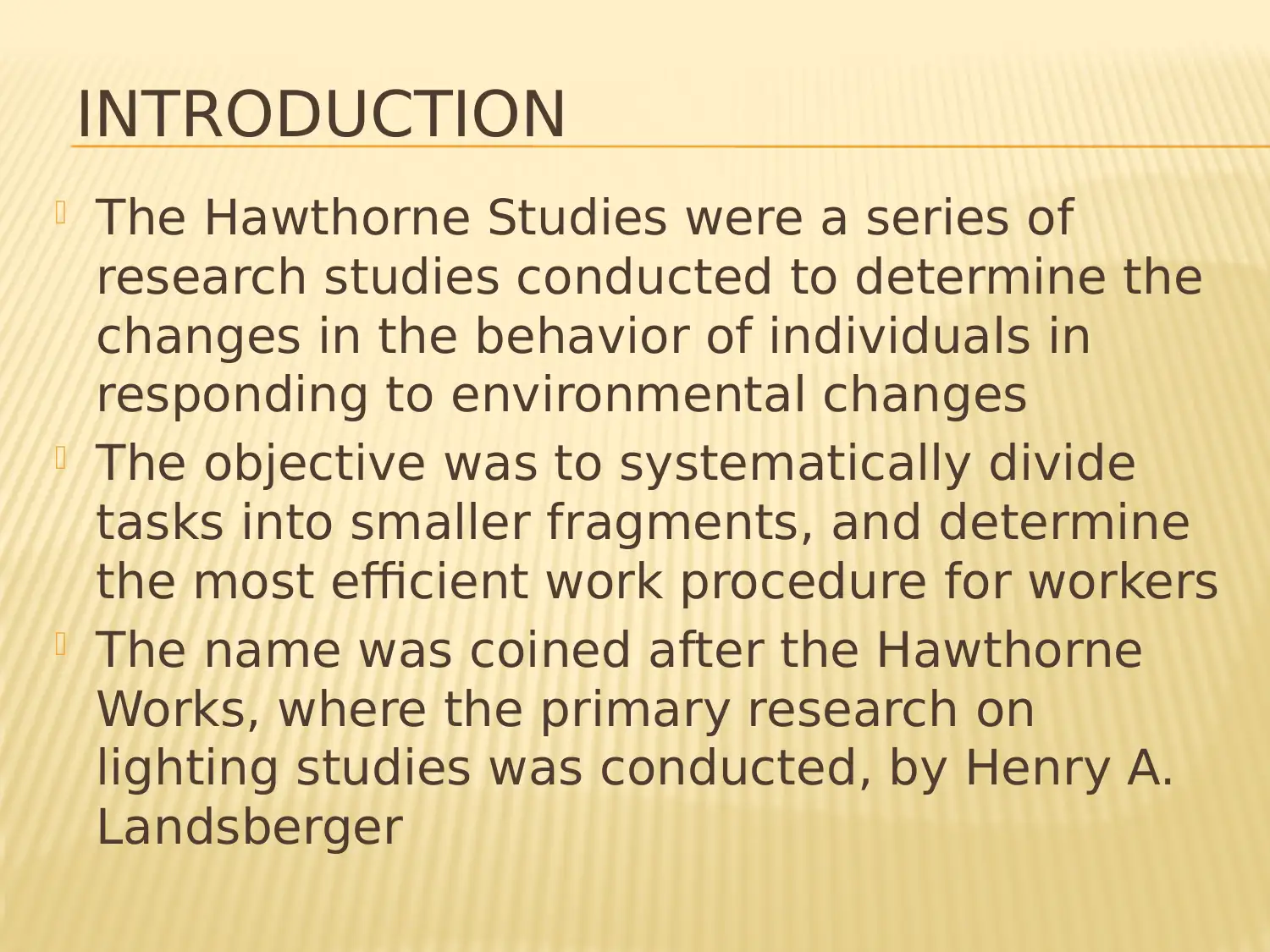
INTRODUCTION
The Hawthorne Studies were a series of
research studies conducted to determine the
changes in the behavior of individuals in
responding to environmental changes
The objective was to systematically divide
tasks into smaller fragments, and determine
the most efficient work procedure for workers
The name was coined after the Hawthorne
Works, where the primary research on
lighting studies was conducted, by Henry A.
Landsberger
The Hawthorne Studies were a series of
research studies conducted to determine the
changes in the behavior of individuals in
responding to environmental changes
The objective was to systematically divide
tasks into smaller fragments, and determine
the most efficient work procedure for workers
The name was coined after the Hawthorne
Works, where the primary research on
lighting studies was conducted, by Henry A.
Landsberger
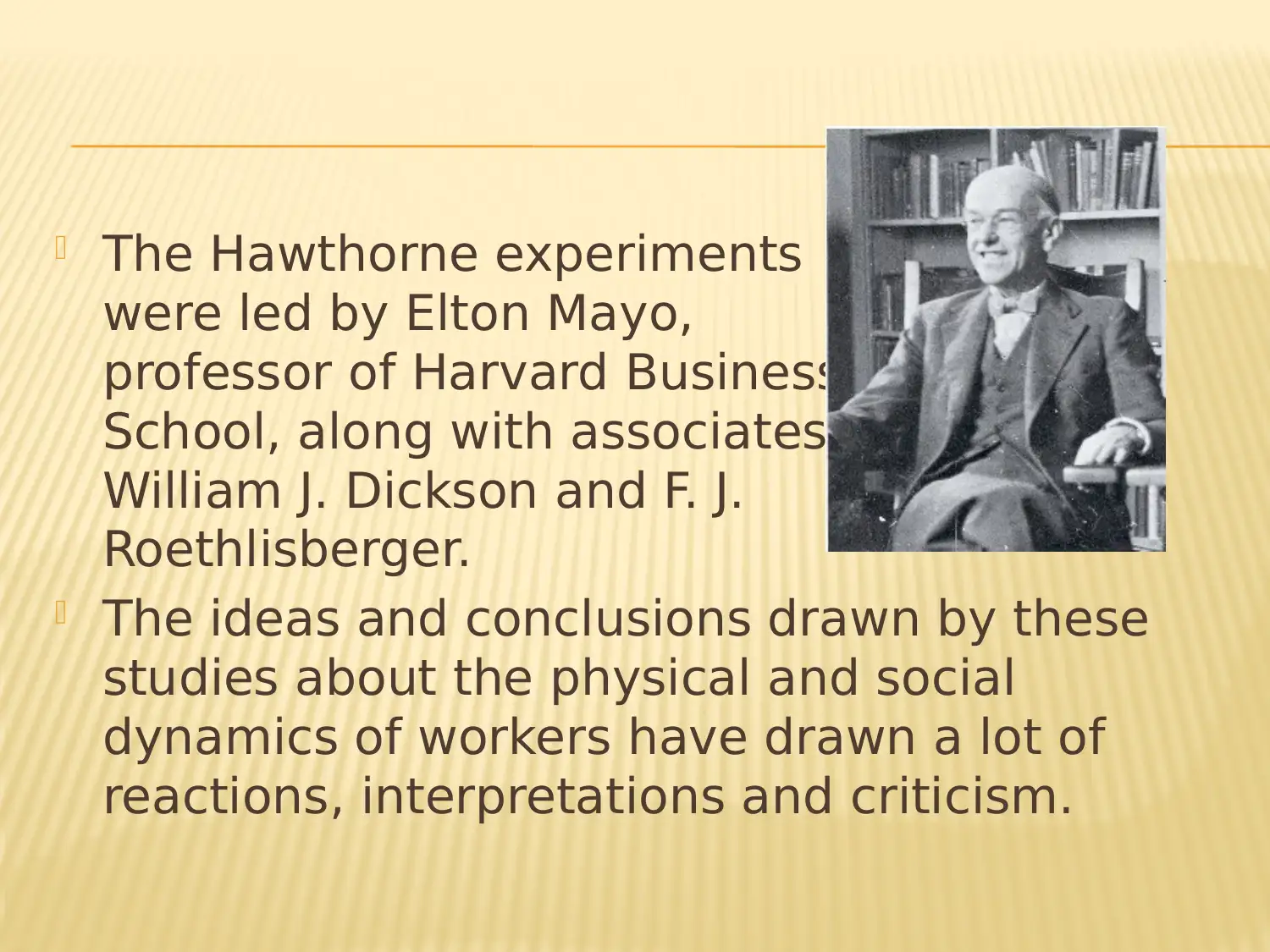
The Hawthorne experiments
were led by Elton Mayo,
professor of Harvard Business
School, along with associates
William J. Dickson and F. J.
Roethlisberger.
The ideas and conclusions drawn by these
studies about the physical and social
dynamics of workers have drawn a lot of
reactions, interpretations and criticism.
were led by Elton Mayo,
professor of Harvard Business
School, along with associates
William J. Dickson and F. J.
Roethlisberger.
The ideas and conclusions drawn by these
studies about the physical and social
dynamics of workers have drawn a lot of
reactions, interpretations and criticism.
⊘ This is a preview!⊘
Do you want full access?
Subscribe today to unlock all pages.

Trusted by 1+ million students worldwide
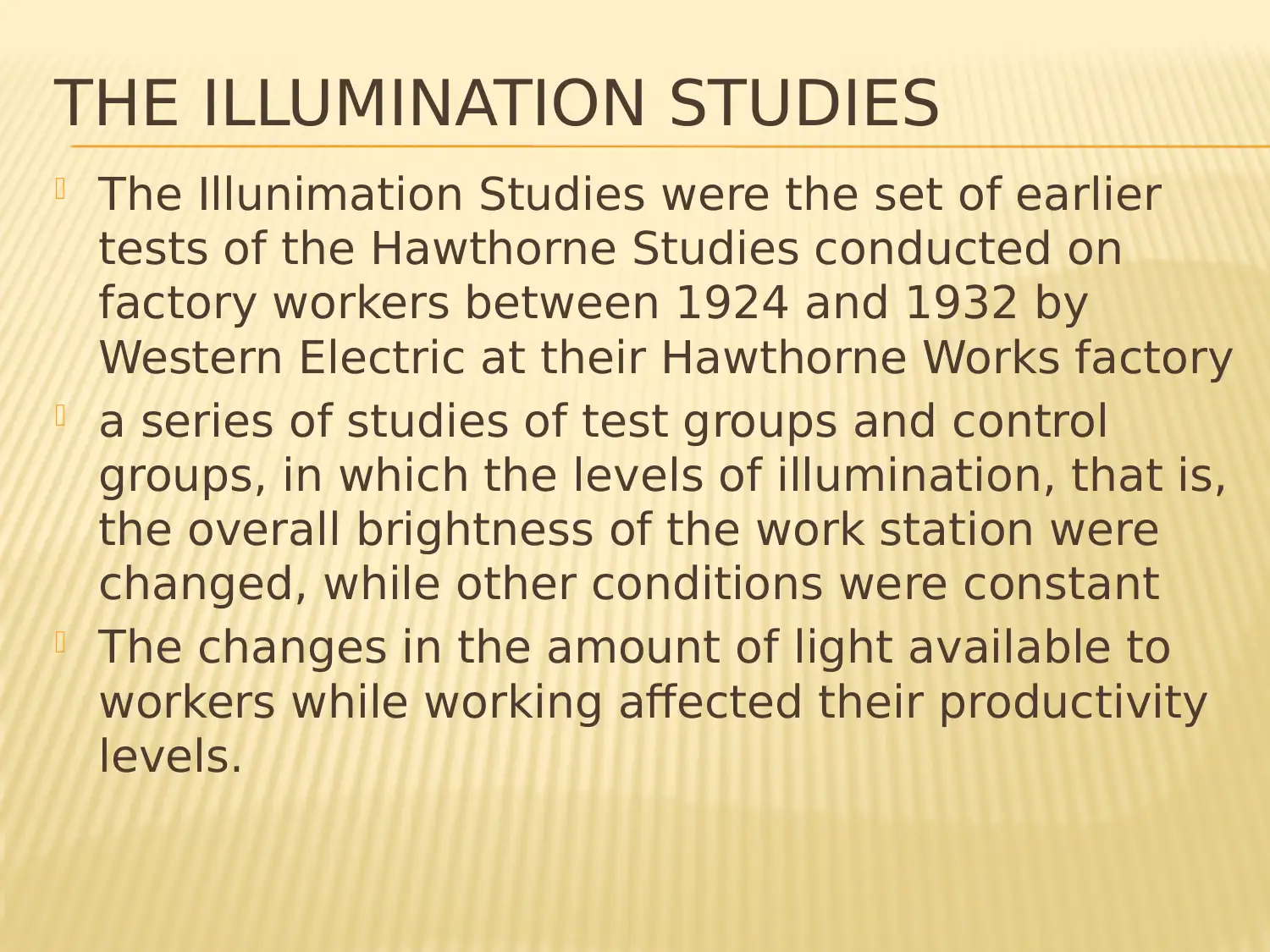
THE ILLUMINATION STUDIES
The Illunimation Studies were the set of earlier
tests of the Hawthorne Studies conducted on
factory workers between 1924 and 1932 by
Western Electric at their Hawthorne Works factory
a series of studies of test groups and control
groups, in which the levels of illumination, that is,
the overall brightness of the work station were
changed, while other conditions were constant
The changes in the amount of light available to
workers while working affected their productivity
levels.
The Illunimation Studies were the set of earlier
tests of the Hawthorne Studies conducted on
factory workers between 1924 and 1932 by
Western Electric at their Hawthorne Works factory
a series of studies of test groups and control
groups, in which the levels of illumination, that is,
the overall brightness of the work station were
changed, while other conditions were constant
The changes in the amount of light available to
workers while working affected their productivity
levels.
Paraphrase This Document
Need a fresh take? Get an instant paraphrase of this document with our AI Paraphraser
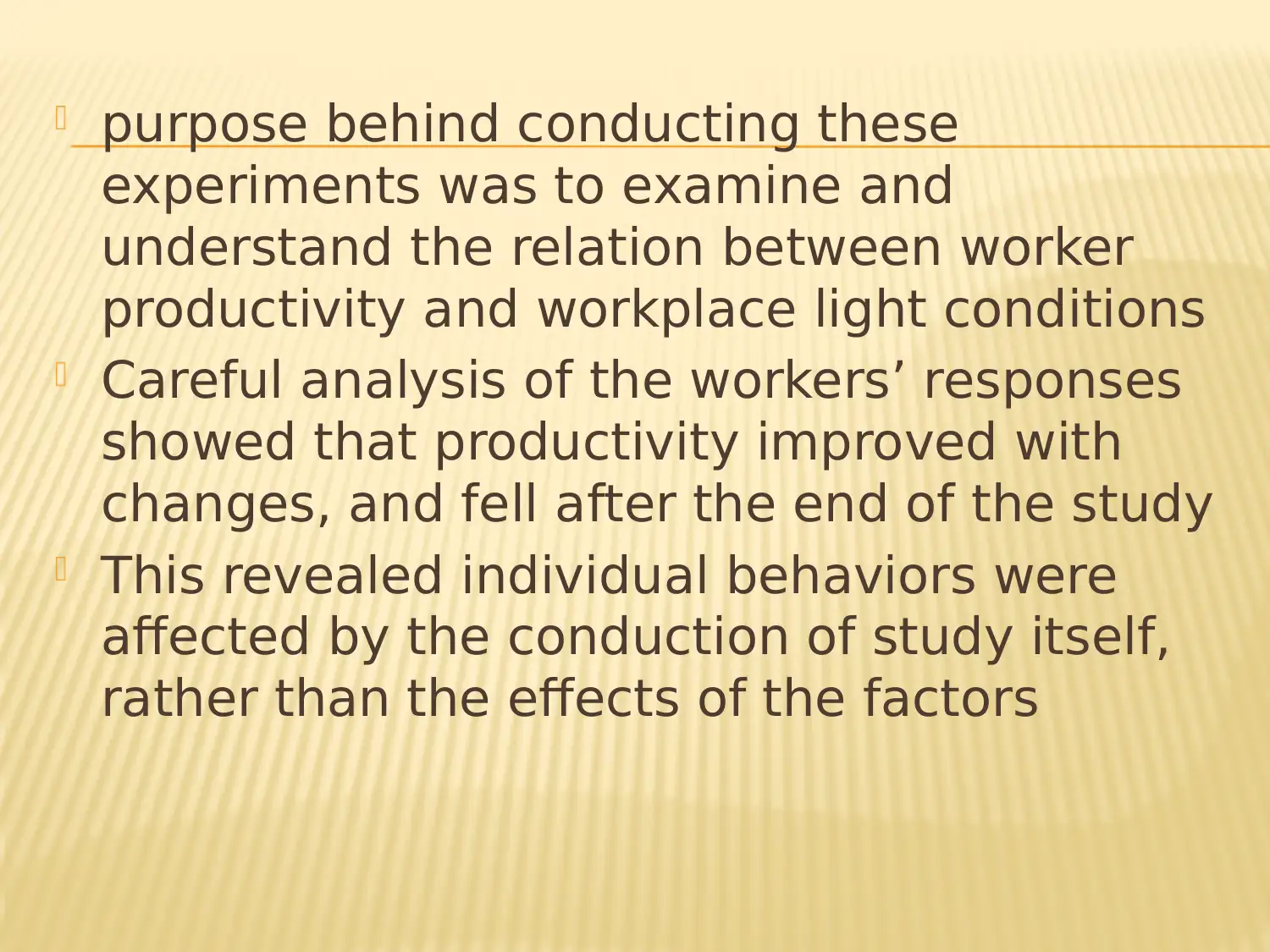
purpose behind conducting these
experiments was to examine and
understand the relation between worker
productivity and workplace light conditions
Careful analysis of the workers’ responses
showed that productivity improved with
changes, and fell after the end of the study
This revealed individual behaviors were
affected by the conduction of study itself,
rather than the effects of the factors
experiments was to examine and
understand the relation between worker
productivity and workplace light conditions
Careful analysis of the workers’ responses
showed that productivity improved with
changes, and fell after the end of the study
This revealed individual behaviors were
affected by the conduction of study itself,
rather than the effects of the factors
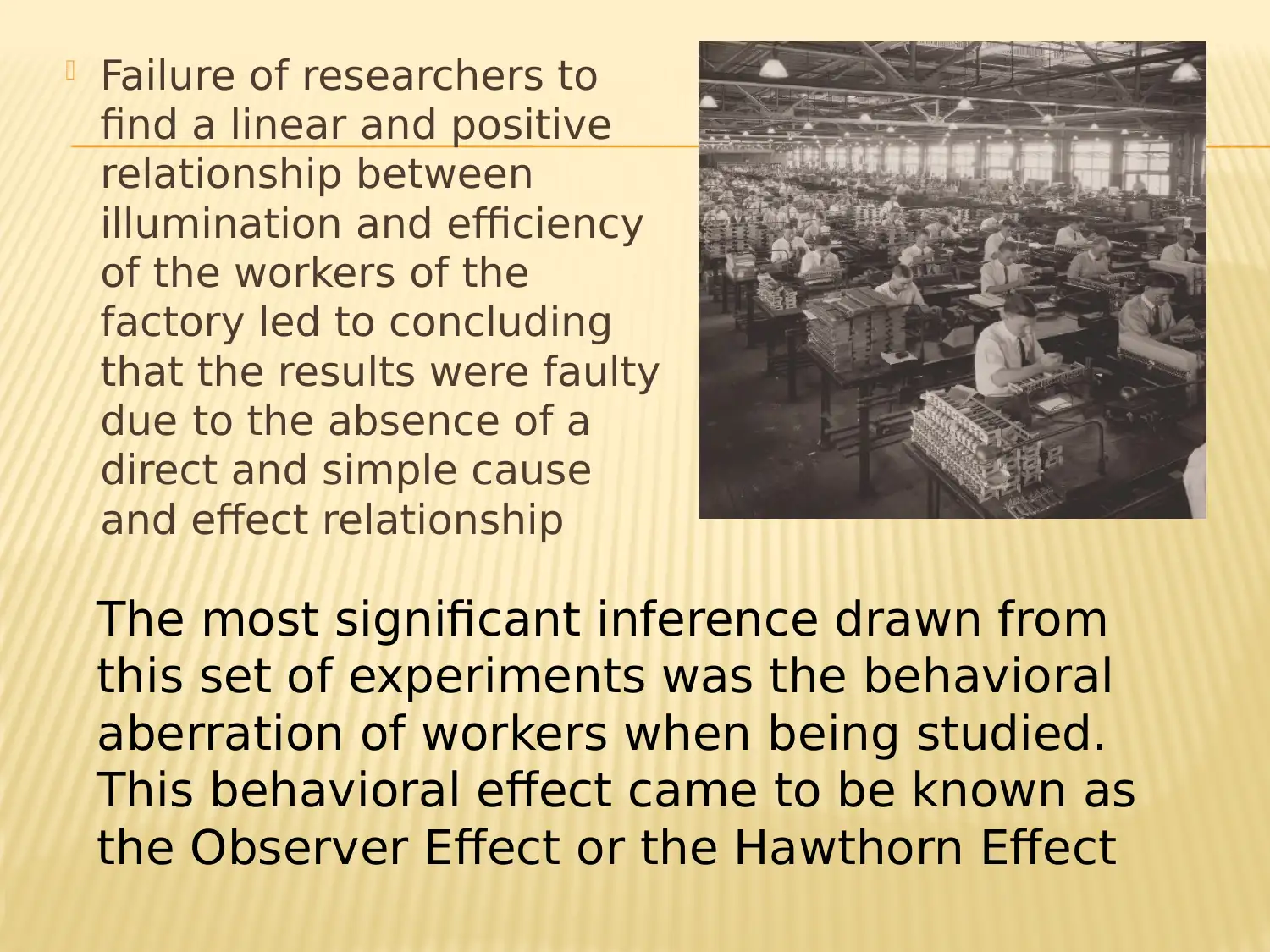
Failure of researchers to
find a linear and positive
relationship between
illumination and efficiency
of the workers of the
factory led to concluding
that the results were faulty
due to the absence of a
direct and simple cause
and effect relationship
The most significant inference drawn from
this set of experiments was the behavioral
aberration of workers when being studied.
This behavioral effect came to be known as
the Observer Effect or the Hawthorn Effect
find a linear and positive
relationship between
illumination and efficiency
of the workers of the
factory led to concluding
that the results were faulty
due to the absence of a
direct and simple cause
and effect relationship
The most significant inference drawn from
this set of experiments was the behavioral
aberration of workers when being studied.
This behavioral effect came to be known as
the Observer Effect or the Hawthorn Effect
⊘ This is a preview!⊘
Do you want full access?
Subscribe today to unlock all pages.

Trusted by 1+ million students worldwide
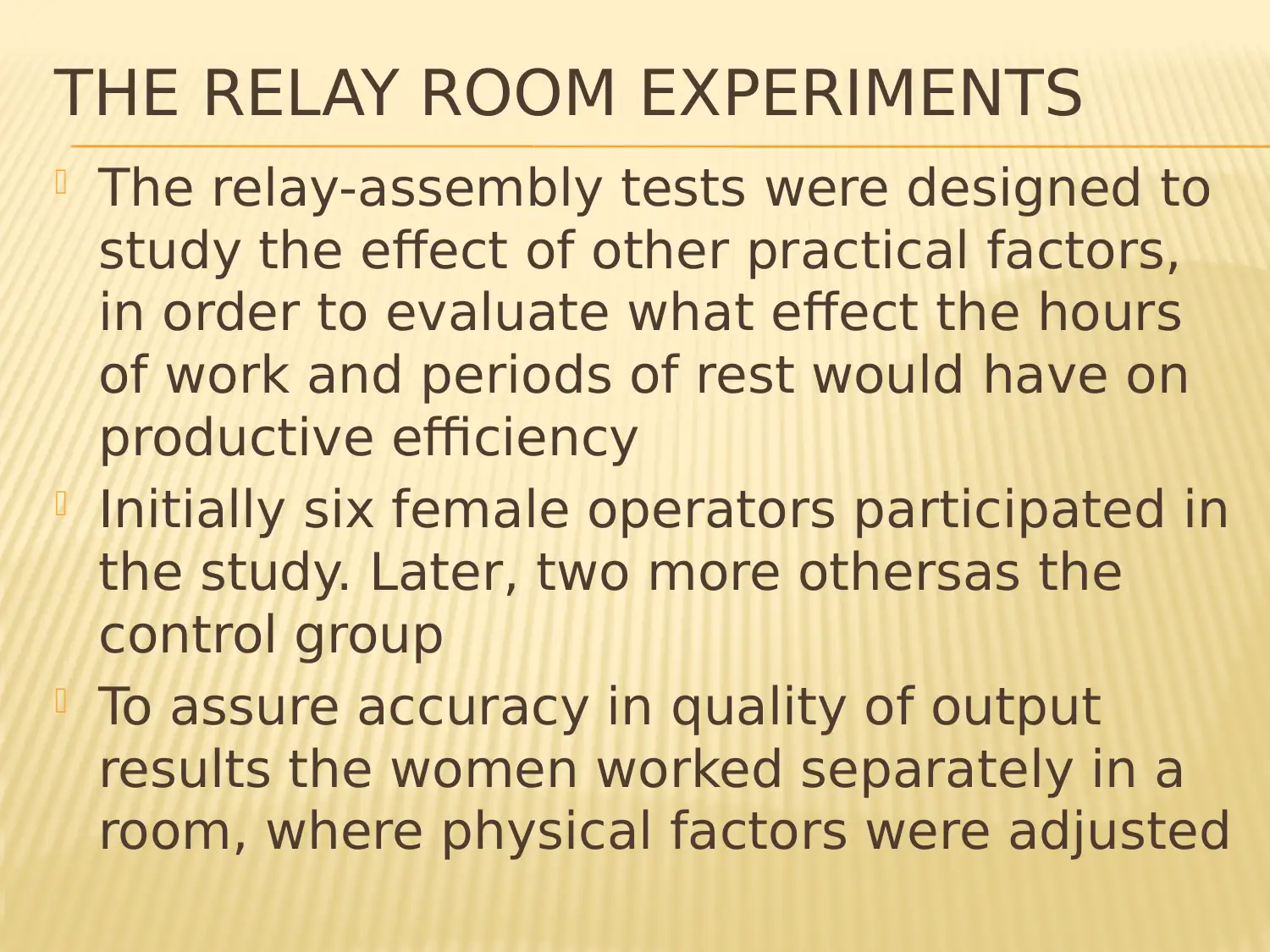
THE RELAY ROOM EXPERIMENTS
The relay-assembly tests were designed to
study the effect of other practical factors,
in order to evaluate what effect the hours
of work and periods of rest would have on
productive efficiency
Initially six female operators participated in
the study. Later, two more othersas the
control group
To assure accuracy in quality of output
results the women worked separately in a
room, where physical factors were adjusted
The relay-assembly tests were designed to
study the effect of other practical factors,
in order to evaluate what effect the hours
of work and periods of rest would have on
productive efficiency
Initially six female operators participated in
the study. Later, two more othersas the
control group
To assure accuracy in quality of output
results the women worked separately in a
room, where physical factors were adjusted
Paraphrase This Document
Need a fresh take? Get an instant paraphrase of this document with our AI Paraphraser
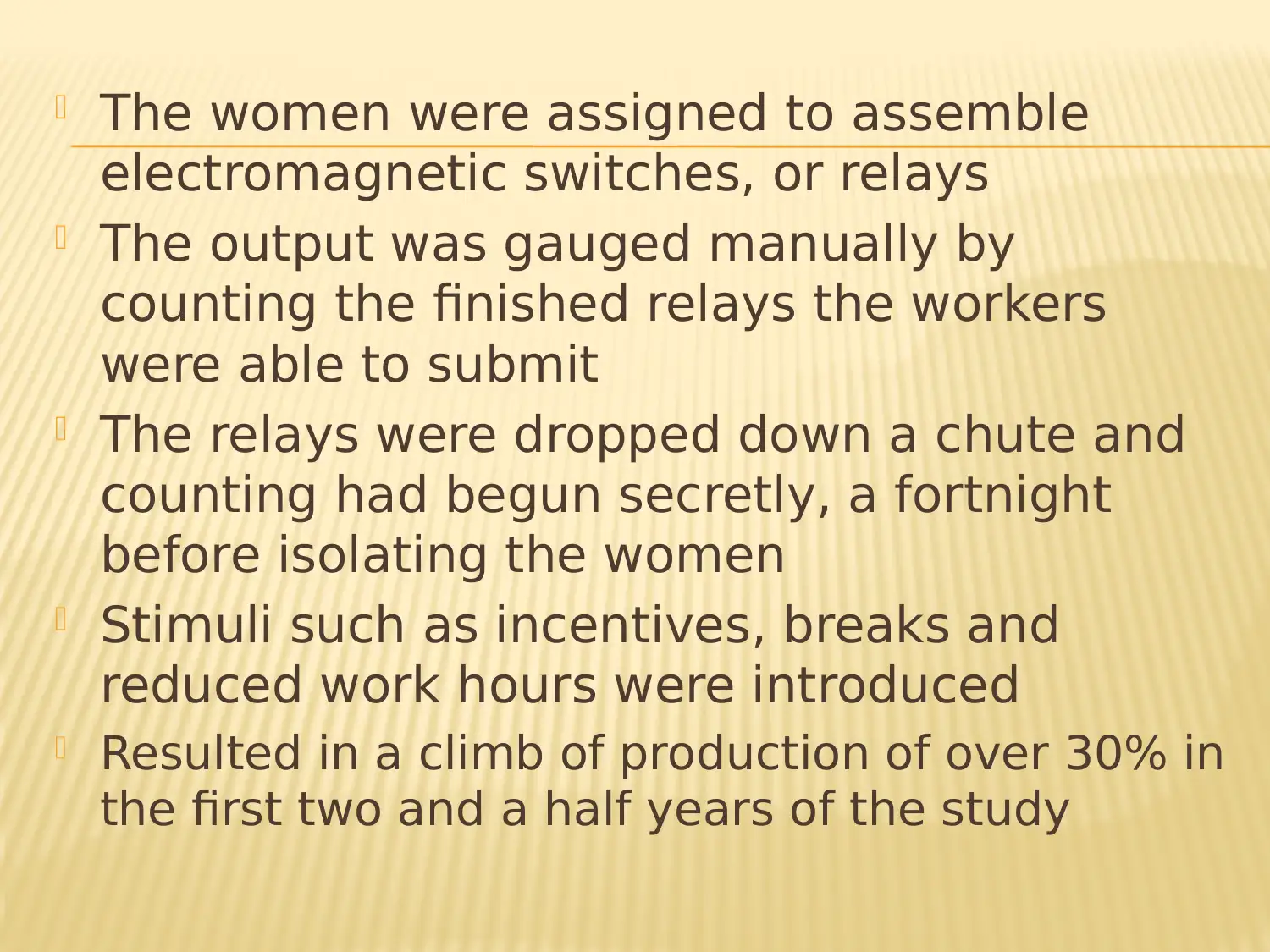
The women were assigned to assemble
electromagnetic switches, or relays
The output was gauged manually by
counting the finished relays the workers
were able to submit
The relays were dropped down a chute and
counting had begun secretly, a fortnight
before isolating the women
Stimuli such as incentives, breaks and
reduced work hours were introduced
Resulted in a climb of production of over 30% in
the first two and a half years of the study
electromagnetic switches, or relays
The output was gauged manually by
counting the finished relays the workers
were able to submit
The relays were dropped down a chute and
counting had begun secretly, a fortnight
before isolating the women
Stimuli such as incentives, breaks and
reduced work hours were introduced
Resulted in a climb of production of over 30% in
the first two and a half years of the study
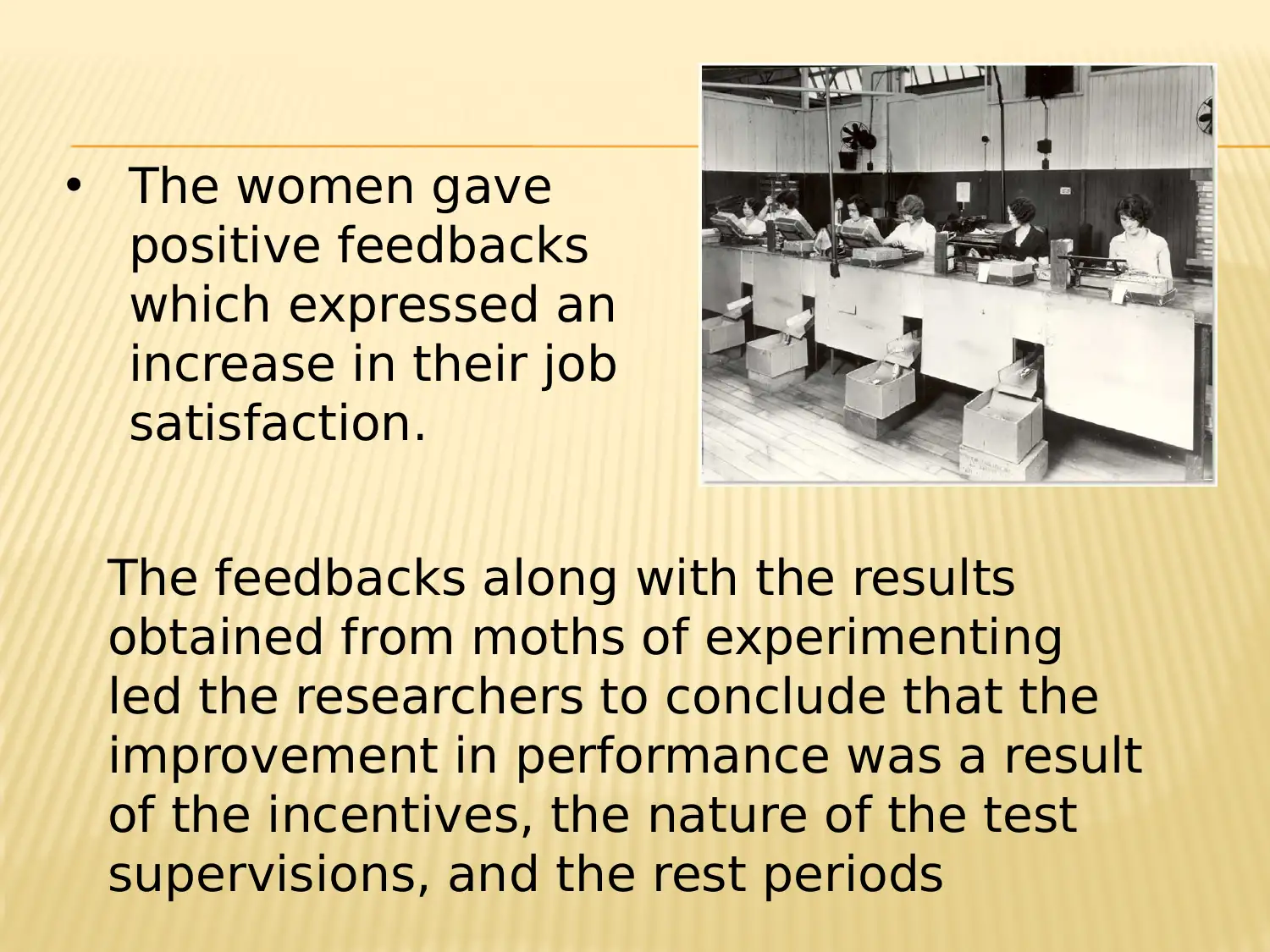
• The women gave
positive feedbacks
which expressed an
increase in their job
satisfaction.
The feedbacks along with the results
obtained from moths of experimenting
led the researchers to conclude that the
improvement in performance was a result
of the incentives, the nature of the test
supervisions, and the rest periods
positive feedbacks
which expressed an
increase in their job
satisfaction.
The feedbacks along with the results
obtained from moths of experimenting
led the researchers to conclude that the
improvement in performance was a result
of the incentives, the nature of the test
supervisions, and the rest periods
⊘ This is a preview!⊘
Do you want full access?
Subscribe today to unlock all pages.

Trusted by 1+ million students worldwide
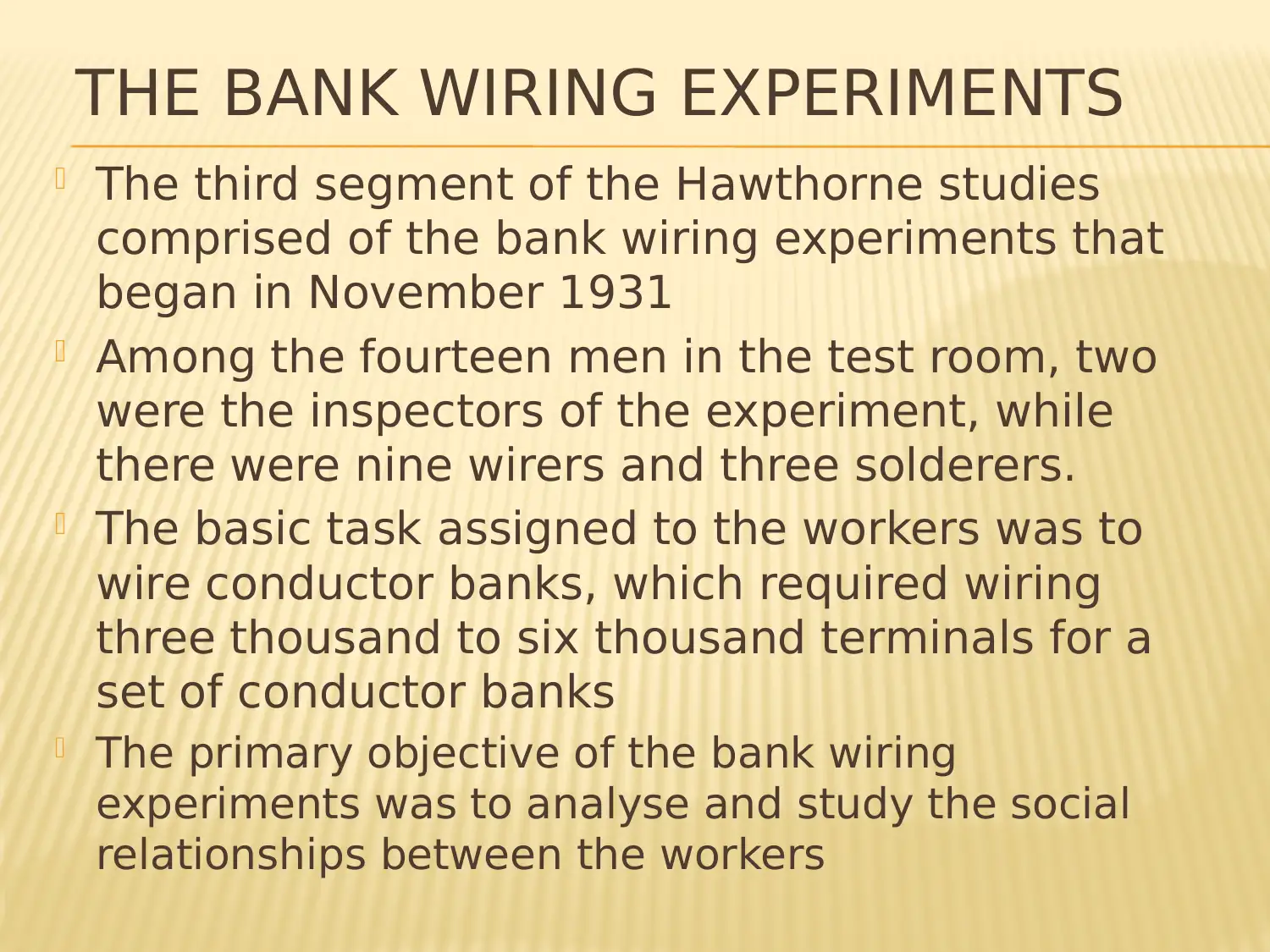
THE BANK WIRING EXPERIMENTS
The third segment of the Hawthorne studies
comprised of the bank wiring experiments that
began in November 1931
Among the fourteen men in the test room, two
were the inspectors of the experiment, while
there were nine wirers and three solderers.
The basic task assigned to the workers was to
wire conductor banks, which required wiring
three thousand to six thousand terminals for a
set of conductor banks
The primary objective of the bank wiring
experiments was to analyse and study the social
relationships between the workers
The third segment of the Hawthorne studies
comprised of the bank wiring experiments that
began in November 1931
Among the fourteen men in the test room, two
were the inspectors of the experiment, while
there were nine wirers and three solderers.
The basic task assigned to the workers was to
wire conductor banks, which required wiring
three thousand to six thousand terminals for a
set of conductor banks
The primary objective of the bank wiring
experiments was to analyse and study the social
relationships between the workers
Paraphrase This Document
Need a fresh take? Get an instant paraphrase of this document with our AI Paraphraser
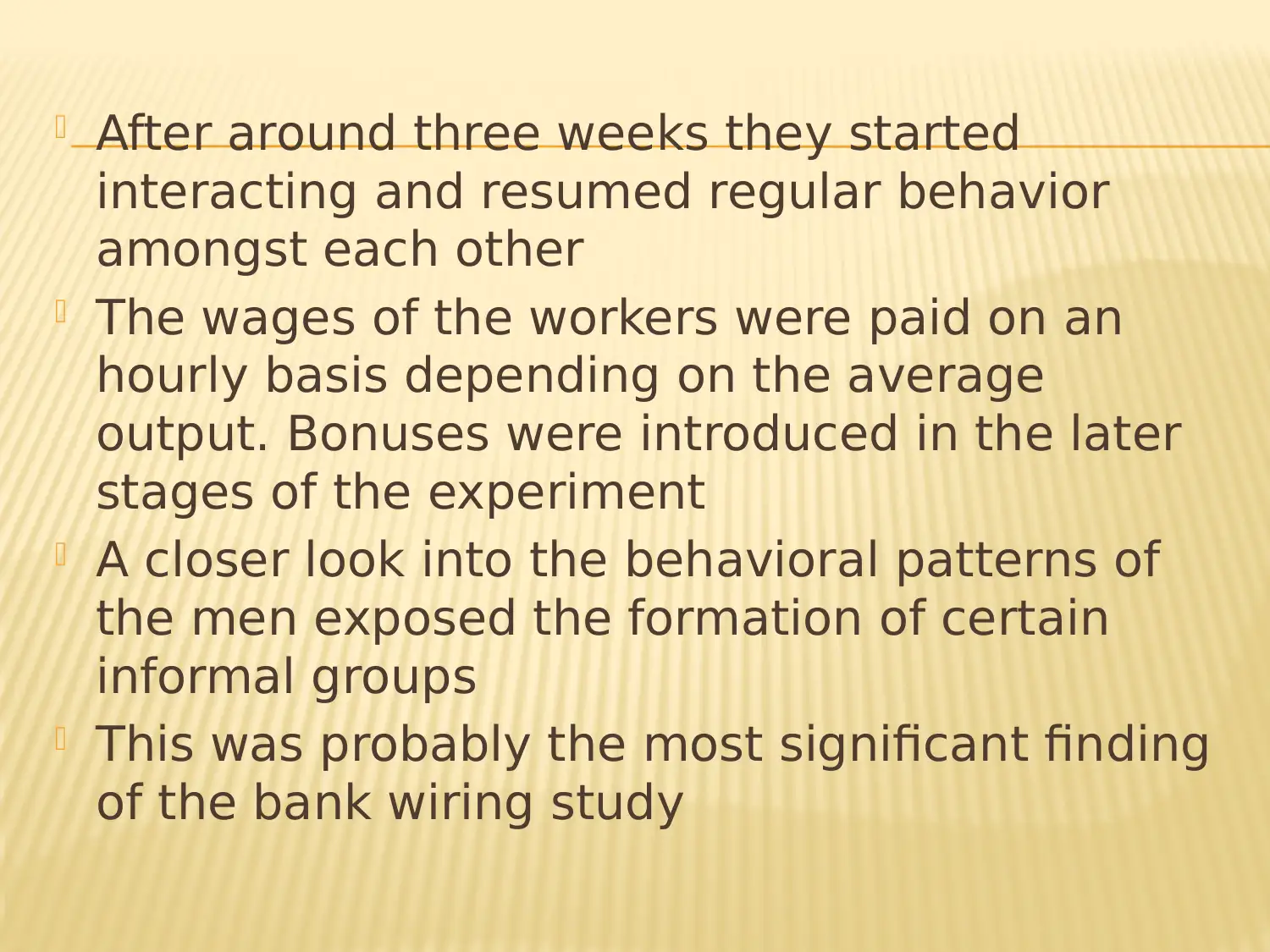
After around three weeks they started
interacting and resumed regular behavior
amongst each other
The wages of the workers were paid on an
hourly basis depending on the average
output. Bonuses were introduced in the later
stages of the experiment
A closer look into the behavioral patterns of
the men exposed the formation of certain
informal groups
This was probably the most significant finding
of the bank wiring study
interacting and resumed regular behavior
amongst each other
The wages of the workers were paid on an
hourly basis depending on the average
output. Bonuses were introduced in the later
stages of the experiment
A closer look into the behavioral patterns of
the men exposed the formation of certain
informal groups
This was probably the most significant finding
of the bank wiring study
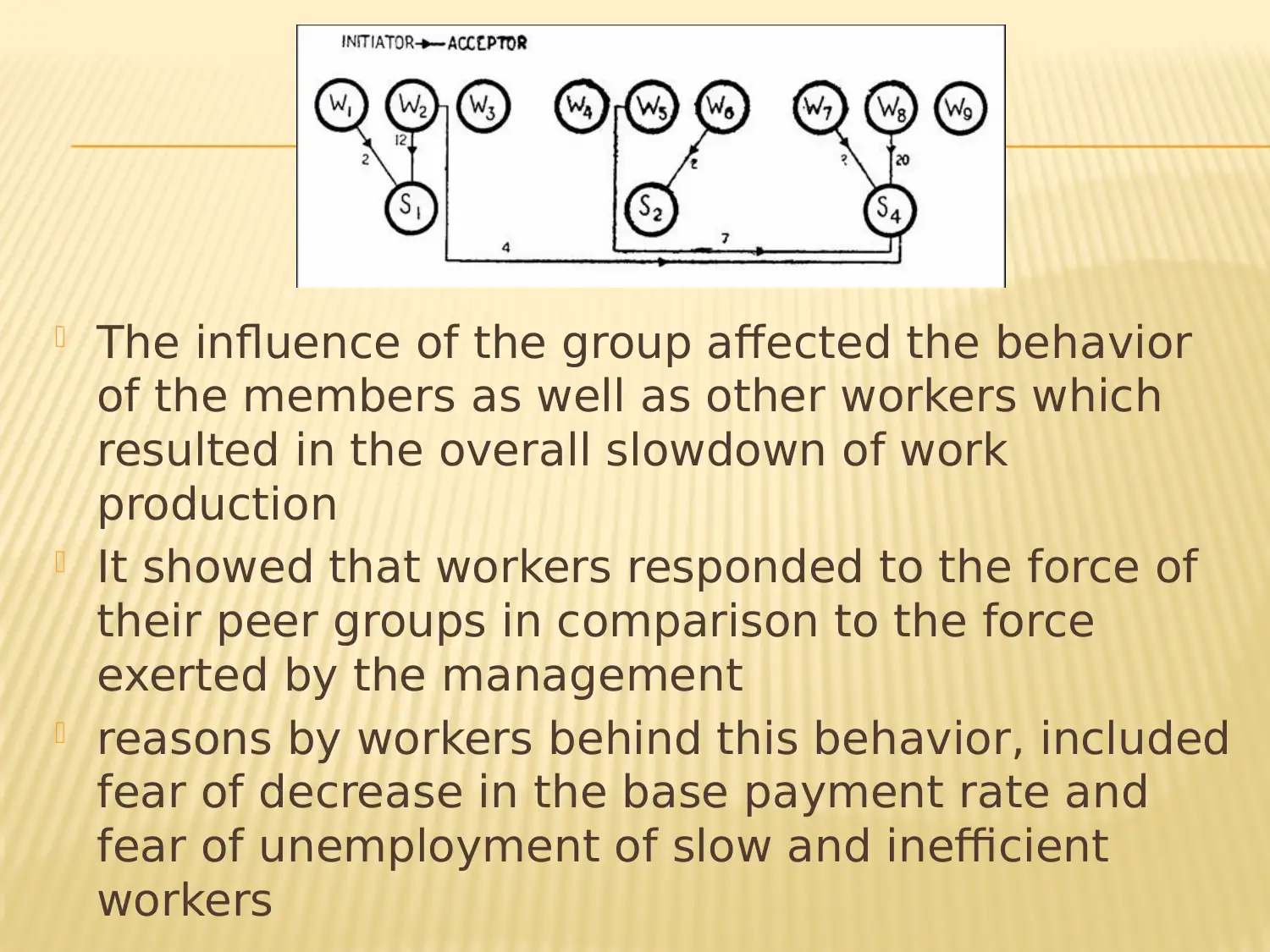
The influence of the group affected the behavior
of the members as well as other workers which
resulted in the overall slowdown of work
production
It showed that workers responded to the force of
their peer groups in comparison to the force
exerted by the management
reasons by workers behind this behavior, included
fear of decrease in the base payment rate and
fear of unemployment of slow and inefficient
workers
of the members as well as other workers which
resulted in the overall slowdown of work
production
It showed that workers responded to the force of
their peer groups in comparison to the force
exerted by the management
reasons by workers behind this behavior, included
fear of decrease in the base payment rate and
fear of unemployment of slow and inefficient
workers
⊘ This is a preview!⊘
Do you want full access?
Subscribe today to unlock all pages.

Trusted by 1+ million students worldwide
1 out of 15
Related Documents
Your All-in-One AI-Powered Toolkit for Academic Success.
+13062052269
info@desklib.com
Available 24*7 on WhatsApp / Email
![[object Object]](/_next/static/media/star-bottom.7253800d.svg)
Unlock your academic potential
Copyright © 2020–2025 A2Z Services. All Rights Reserved. Developed and managed by ZUCOL.



